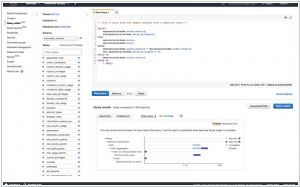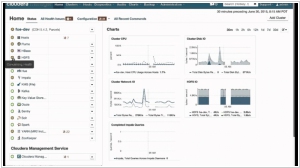Amazon Redshift vs Cloudera
March 12, 2025 | Author: Michael Stromann
12★
Amazon Redshift is a fast, fully managed, petabyte-scale data warehouse service that makes it simple and cost-effective to efficiently analyze all your data using your existing business intelligence tools. You can start small for just $0.25 per hour with no commitments or upfront costs and scale to a petabyte or more for $1,000 per terabyte per year, less than a tenth of most other data warehousing solutions.
12★
Cloudera helps you become information-driven by leveraging the best of the open source community with the enterprise capabilities you need to succeed with Apache Hadoop in your organization. Designed specifically for mission-critical environments, Cloudera Enterprise includes CDH, the world’s most popular open source Hadoop-based platform, as well as advanced system management and data management tools plus dedicated support and community advocacy from our world-class team of Hadoop developers and experts. Cloudera is your partner on the path to big data.
See also:
Top 10 Big Data platforms
Top 10 Big Data platforms
Amazon Redshift and Cloudera, despite sounding like intergalactic battlecruisers, are actually two different ways to store and analyze absurd amounts of data. Both let you poke around in vast pools of structured information using SQL, which is a language designed to make you feel smarter than you really are. They thrive on parallel processing, which is just a fancy way of saying they can do lots of things at once without complaining. Both integrate with business intelligence tools, because nothing says "intelligent" quite like making graphs that no one understands but still nods at approvingly.
Redshift, brought into existence by the great and powerful Amazon in 2012, is a cloud-only entity, meaning it floats somewhere in the vast ether of AWS like a smug digital deity. It’s built for speed, using columnar storage, compression and other magic tricks to run analytics faster than you can explain what "ETL" actually stands for. Its primary purpose is to provide enterprises with a scalable data warehouse without the hassle of, well, actually having to warehouse anything themselves. You pay as you go, which is a bit like a taxi meter that only charges you when you’re looking at your spreadsheet.
Cloudera, on the other hand, hails from the ancient and mysterious year of 2008 and was built on the noble shoulders of Apache Hadoop and Spark. Unlike Redshift, it doesn’t believe in being tied down to a single form—it runs on-premises, in the cloud or presumably in any sufficiently advanced toaster. It’s less about pure data warehousing and more about massive-scale analytics, machine learning and generally trying to make sense of the digital chaos we’ve inflicted upon ourselves. Unlike Redshift's rental model, Cloudera prefers subscriptions, ensuring that you’re always paying for something, even if you don’t remember exactly what.
See also: Top 10 Big Data platforms
Redshift, brought into existence by the great and powerful Amazon in 2012, is a cloud-only entity, meaning it floats somewhere in the vast ether of AWS like a smug digital deity. It’s built for speed, using columnar storage, compression and other magic tricks to run analytics faster than you can explain what "ETL" actually stands for. Its primary purpose is to provide enterprises with a scalable data warehouse without the hassle of, well, actually having to warehouse anything themselves. You pay as you go, which is a bit like a taxi meter that only charges you when you’re looking at your spreadsheet.
Cloudera, on the other hand, hails from the ancient and mysterious year of 2008 and was built on the noble shoulders of Apache Hadoop and Spark. Unlike Redshift, it doesn’t believe in being tied down to a single form—it runs on-premises, in the cloud or presumably in any sufficiently advanced toaster. It’s less about pure data warehousing and more about massive-scale analytics, machine learning and generally trying to make sense of the digital chaos we’ve inflicted upon ourselves. Unlike Redshift's rental model, Cloudera prefers subscriptions, ensuring that you’re always paying for something, even if you don’t remember exactly what.
See also: Top 10 Big Data platforms





